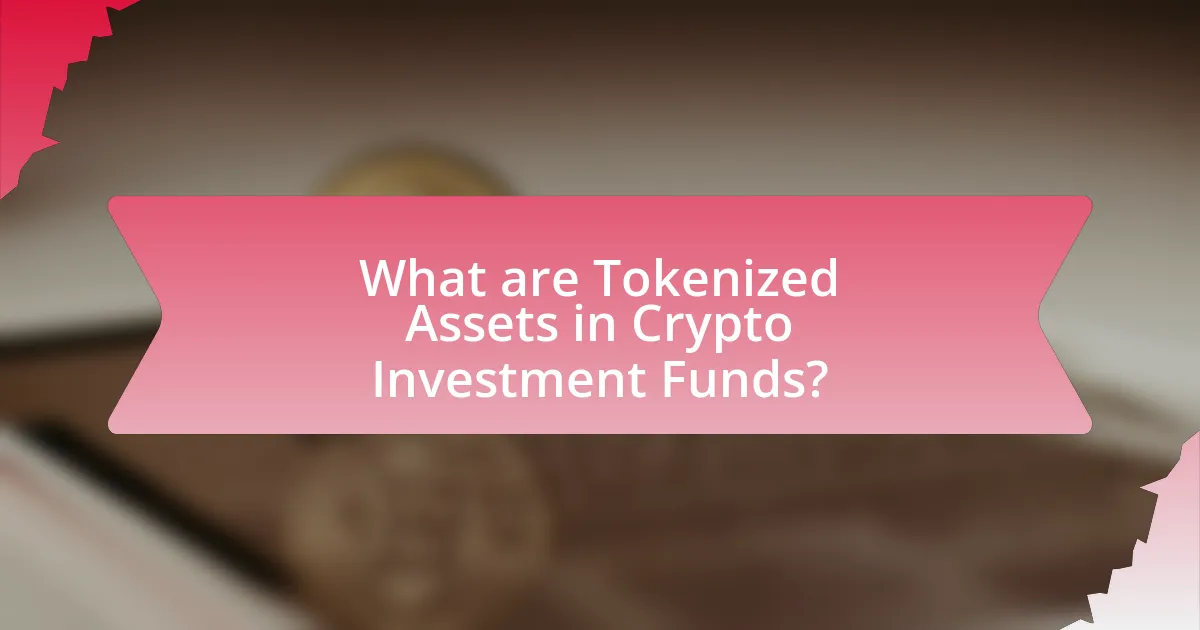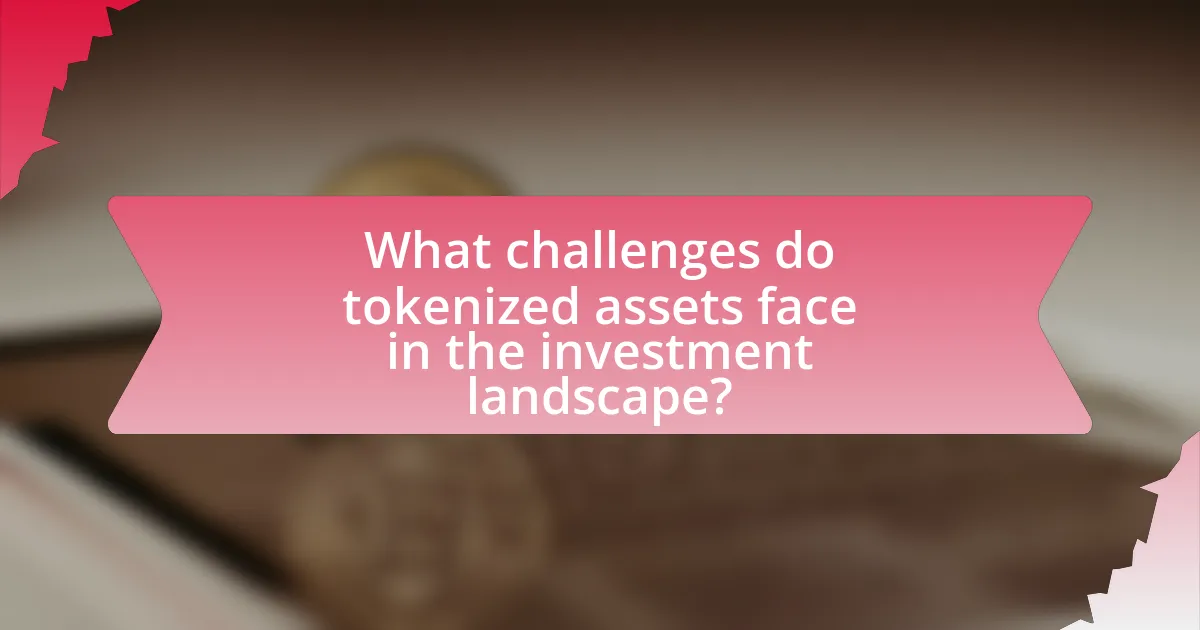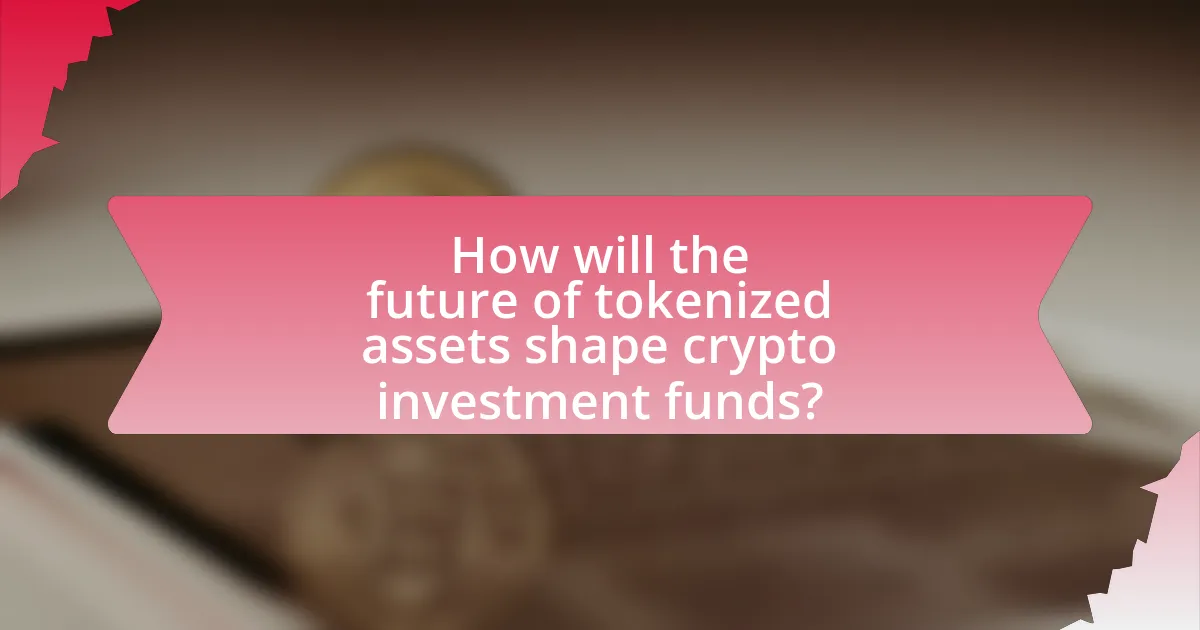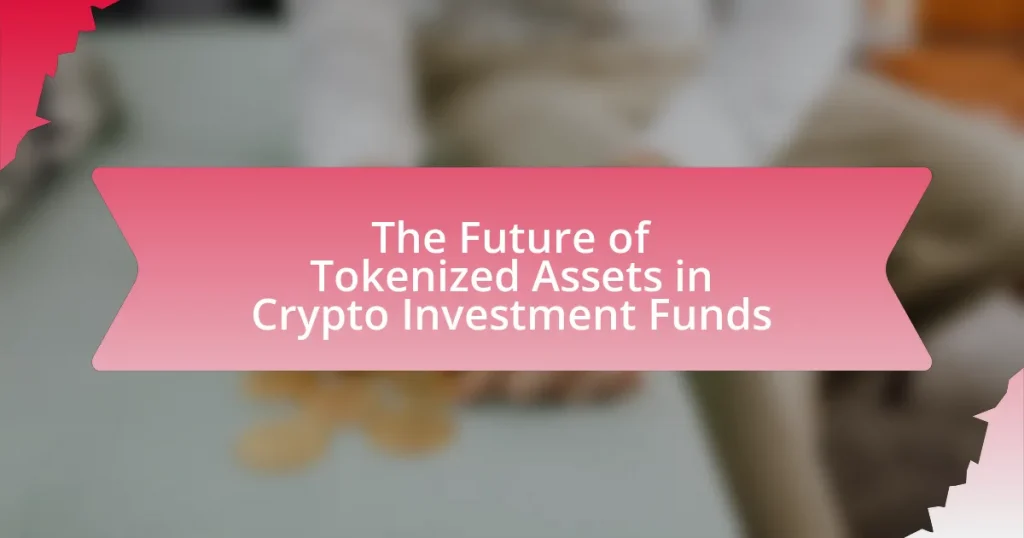Tokenized assets in crypto investment funds represent digital versions of real-world assets, such as real estate and stocks, on a blockchain. This article explores how tokenization enhances liquidity and accessibility through fractional ownership, enabling broader participation in investment markets. It examines the technologies that facilitate tokenization, the differences between tokenized and traditional assets, and the growing popularity of tokenized assets among investors. Additionally, the article addresses the regulatory challenges and technological barriers faced by tokenized assets, while highlighting emerging trends and best practices for investors. The future of tokenized assets is poised to reshape the landscape of crypto investment funds, offering innovative opportunities and strategies for market participants.

What are Tokenized Assets in Crypto Investment Funds?
Tokenized assets in crypto investment funds are digital representations of real-world assets on a blockchain. These assets can include real estate, stocks, or commodities, and they are divided into tokens that can be bought, sold, or traded. The use of blockchain technology ensures transparency, security, and efficiency in transactions, allowing for fractional ownership and increased liquidity. According to a report by the World Economic Forum, tokenized assets could represent up to $24 trillion in global GDP by 2027, highlighting their potential impact on investment funds and the broader financial landscape.
How do tokenized assets function within investment funds?
Tokenized assets function within investment funds by representing ownership of real-world assets on a blockchain, enabling fractional ownership and increased liquidity. These assets are digitized and issued as tokens, which can be easily traded or transferred, allowing investors to buy into funds with lower capital requirements. For example, a real estate investment fund can tokenize properties, allowing multiple investors to own fractions of a property, thus democratizing access to real estate investments. This model enhances transparency and efficiency in transactions, as blockchain technology provides a secure and immutable record of ownership.
What technologies enable the tokenization of assets?
Blockchain technology enables the tokenization of assets by providing a decentralized and secure ledger for recording transactions. This technology allows for the creation of digital tokens that represent ownership of physical or digital assets, ensuring transparency and immutability. Smart contracts, which are self-executing contracts with the terms of the agreement directly written into code, further facilitate the automation of asset management and transfer processes. Additionally, distributed ledger technology (DLT) enhances the efficiency of asset tokenization by allowing multiple parties to access and verify the same data in real-time, reducing the need for intermediaries. These technologies collectively support the seamless integration of tokenized assets into financial systems, promoting liquidity and accessibility in investment markets.
How do tokenized assets differ from traditional assets?
Tokenized assets differ from traditional assets primarily in their digital representation and the underlying technology used for ownership and transfer. Traditional assets, such as real estate or stocks, exist in physical or centralized forms and require intermediaries for transactions, while tokenized assets are represented as digital tokens on a blockchain, enabling peer-to-peer transactions without intermediaries. This blockchain technology enhances transparency, security, and efficiency, as ownership records are immutable and accessible to all participants. Additionally, tokenized assets can be fractionalized, allowing for smaller investment amounts, which is not typically possible with traditional assets.
Why are tokenized assets gaining popularity in crypto investment funds?
Tokenized assets are gaining popularity in crypto investment funds due to their ability to enhance liquidity and accessibility. By converting physical or traditional assets into digital tokens on a blockchain, investors can trade these assets more easily and efficiently. This process allows for fractional ownership, enabling a broader range of investors to participate in markets that were previously limited to high-net-worth individuals. Additionally, the transparency and security provided by blockchain technology further attract investors, as it reduces the risks associated with fraud and mismanagement. According to a report by Deloitte, the tokenization of assets could unlock $1.4 trillion in value by 2025, highlighting the significant potential and growing interest in this investment approach.
What advantages do tokenized assets offer to investors?
Tokenized assets offer investors enhanced liquidity, fractional ownership, and increased accessibility. Liquidity is improved because tokenized assets can be traded on various digital platforms 24/7, allowing for quicker transactions compared to traditional assets. Fractional ownership enables investors to purchase a portion of high-value assets, making it feasible for a broader range of investors to participate in markets that were previously out of reach. Additionally, tokenized assets can be accessed globally, breaking down geographical barriers and allowing investors from different regions to invest in diverse asset classes. These advantages are supported by the growing adoption of blockchain technology, which facilitates secure and transparent transactions, further validating the benefits of tokenized assets in the investment landscape.
How do tokenized assets enhance liquidity in investment funds?
Tokenized assets enhance liquidity in investment funds by enabling fractional ownership and facilitating real-time trading on blockchain platforms. This fractionalization allows investors to buy and sell smaller portions of assets, increasing market participation and reducing barriers to entry. Furthermore, the use of blockchain technology ensures transparent and efficient transactions, which can significantly decrease settlement times compared to traditional asset trading. For instance, a study by the World Economic Forum in 2020 highlighted that tokenization could potentially unlock $24 trillion in illiquid assets, demonstrating the substantial impact on liquidity.

What challenges do tokenized assets face in the investment landscape?
Tokenized assets face several challenges in the investment landscape, including regulatory uncertainty, market volatility, and technological barriers. Regulatory uncertainty arises because many jurisdictions have not established clear guidelines for tokenized assets, leading to potential legal risks for investors and issuers. Market volatility is a significant concern, as the value of tokenized assets can fluctuate dramatically, impacting investor confidence and long-term viability. Additionally, technological barriers, such as the need for robust security measures and user-friendly platforms, hinder widespread adoption and accessibility. These challenges collectively impede the growth and integration of tokenized assets within traditional investment frameworks.
What regulatory hurdles impact tokenized assets in investment funds?
Regulatory hurdles impacting tokenized assets in investment funds include compliance with securities laws, anti-money laundering (AML) regulations, and tax implications. Investment funds must navigate the complexities of determining whether tokenized assets qualify as securities under the Howey Test, which assesses investment contracts based on the expectation of profits from the efforts of others. Additionally, funds must implement robust AML procedures to prevent illicit activities, as required by the Financial Action Task Force (FATF) guidelines. Tax treatment of tokenized assets can also vary significantly by jurisdiction, complicating reporting and compliance for investment funds. These regulatory challenges can hinder the adoption and integration of tokenized assets in traditional investment frameworks.
How do different jurisdictions approach the regulation of tokenized assets?
Different jurisdictions approach the regulation of tokenized assets through varying frameworks that reflect their legal, economic, and technological contexts. For instance, the United States primarily classifies tokenized assets as securities under the Securities and Exchange Commission (SEC) guidelines, requiring compliance with existing securities laws. In contrast, the European Union is developing a comprehensive regulatory framework known as the Markets in Crypto-Assets (MiCA) regulation, which aims to provide clarity and uniformity across member states while addressing consumer protection and market integrity. Additionally, countries like Switzerland have adopted a more progressive stance, recognizing tokenized assets as part of their financial market infrastructure and providing specific legal definitions and guidelines for their issuance and trading. These regulatory approaches highlight the diverse methodologies jurisdictions employ to manage the complexities of tokenized assets, influenced by their respective economic goals and legal traditions.
What compliance issues must crypto investment funds address?
Crypto investment funds must address several compliance issues, including anti-money laundering (AML) regulations, know your customer (KYC) requirements, and securities laws. AML regulations require funds to implement measures to detect and report suspicious activities, ensuring they do not facilitate money laundering or terrorist financing. KYC requirements mandate that funds verify the identity of their investors to prevent fraud and ensure compliance with financial regulations. Additionally, securities laws dictate how crypto assets are classified and traded, necessitating that funds adhere to registration and reporting obligations to avoid legal repercussions. These compliance issues are critical for maintaining the integrity of the financial system and protecting investors.
What technological challenges exist for tokenized assets?
Tokenized assets face several technological challenges, including scalability, interoperability, and security. Scalability issues arise as blockchain networks struggle to handle a high volume of transactions efficiently, which can hinder the adoption of tokenized assets in large-scale applications. Interoperability challenges occur when different blockchain platforms cannot communicate or exchange data seamlessly, limiting the usability of tokenized assets across various ecosystems. Security concerns, particularly regarding smart contracts and potential vulnerabilities, pose risks that can lead to financial losses or breaches. These challenges are critical as they impact the overall functionality and trustworthiness of tokenized assets in the evolving landscape of crypto investment funds.
How does blockchain technology influence the security of tokenized assets?
Blockchain technology enhances the security of tokenized assets through its decentralized and immutable nature. By utilizing cryptographic techniques, blockchain ensures that transactions involving tokenized assets are securely recorded and cannot be altered retroactively. This immutability protects against fraud and unauthorized changes, as each transaction is linked to the previous one, creating a transparent and verifiable chain of ownership. Furthermore, the decentralized structure of blockchain eliminates single points of failure, reducing the risk of hacking or data breaches. According to a report by the World Economic Forum, blockchain could secure up to $24 trillion in global assets by 2027, highlighting its potential to safeguard tokenized assets effectively.
What scalability issues do tokenized assets encounter?
Tokenized assets encounter scalability issues primarily due to limitations in blockchain technology, such as transaction throughput and network congestion. For instance, many blockchain networks, like Ethereum, can process only a limited number of transactions per second, which can lead to delays and increased transaction costs during peak usage times. According to a report by the Ethereum Foundation, the network’s capacity is around 30 transactions per second, which is insufficient for widespread adoption of tokenized assets in high-volume markets. Additionally, the complexity of smart contracts can further exacerbate scalability challenges, as they require more computational resources and can slow down transaction processing.

How will the future of tokenized assets shape crypto investment funds?
The future of tokenized assets will significantly shape crypto investment funds by enhancing liquidity, accessibility, and diversification. Tokenized assets, which represent real-world assets on a blockchain, allow for fractional ownership, enabling investors to participate in high-value assets with lower capital requirements. This democratization of investment opportunities is evidenced by the growth of platforms like RealT and CurioInvest, which have successfully tokenized real estate and luxury cars, respectively. Furthermore, the integration of tokenized assets into investment funds can lead to more efficient trading and settlement processes, as blockchain technology reduces the need for intermediaries, thereby lowering costs and increasing transaction speed. As regulatory frameworks evolve to accommodate these innovations, crypto investment funds will likely adopt tokenized assets more widely, leading to a more robust and diverse investment landscape.
What trends are emerging in the tokenization of assets?
Emerging trends in the tokenization of assets include increased regulatory clarity, the rise of fractional ownership, and the integration of decentralized finance (DeFi) solutions. Regulatory clarity is evolving as governments worldwide establish frameworks to govern tokenized assets, enhancing investor confidence and market stability. Fractional ownership allows investors to purchase smaller portions of high-value assets, democratizing access and increasing liquidity. Additionally, the integration of DeFi solutions facilitates automated trading and lending of tokenized assets, further driving innovation in the market. These trends indicate a shift towards broader adoption and sophistication in the tokenization landscape.
How are institutional investors adapting to tokenized assets?
Institutional investors are adapting to tokenized assets by integrating blockchain technology into their investment strategies and diversifying their portfolios. This adaptation includes investing in tokenized real estate, equities, and other traditional assets, which enhances liquidity and accessibility. For instance, a report by Fidelity Digital Assets indicates that 36% of institutional investors have already invested in digital assets, reflecting a growing acceptance of tokenization as a viable investment avenue. Additionally, firms like BlackRock and Goldman Sachs are exploring tokenized funds, demonstrating a shift towards embracing innovative financial instruments that leverage the benefits of blockchain technology.
What role will decentralized finance (DeFi) play in the future of tokenized assets?
Decentralized finance (DeFi) will play a crucial role in the future of tokenized assets by enabling greater accessibility, liquidity, and efficiency in asset management. DeFi platforms facilitate peer-to-peer transactions without intermediaries, allowing tokenized assets to be traded and utilized in various financial applications seamlessly. For instance, the total value locked in DeFi protocols reached over $80 billion in 2021, demonstrating the growing adoption and potential for integrating tokenized assets into these ecosystems. This integration can enhance the functionality of tokenized assets, allowing for innovative financial products such as collateralized loans and yield farming, ultimately transforming traditional investment paradigms.
What best practices should investors consider when engaging with tokenized assets?
Investors should prioritize due diligence when engaging with tokenized assets. This involves thoroughly researching the underlying asset, understanding the technology behind the tokenization process, and assessing the regulatory environment. For instance, a study by the World Economic Forum indicates that tokenized assets can enhance liquidity and transparency, but investors must be aware of the potential risks, including market volatility and cybersecurity threats. Additionally, investors should consider diversifying their portfolios to mitigate risks associated with specific tokenized assets, as diversification has been shown to reduce overall investment risk.
How can investors assess the risks associated with tokenized assets?
Investors can assess the risks associated with tokenized assets by conducting thorough due diligence, which includes evaluating the underlying asset’s value, the regulatory environment, and the technology used for tokenization. Due diligence involves analyzing the asset’s historical performance, market demand, and potential volatility. Additionally, investors should consider the legal framework governing tokenized assets, as regulations can significantly impact their value and liquidity. For instance, a report by the World Economic Forum highlights that regulatory clarity is essential for the growth of tokenized assets, as it affects investor confidence and market stability. Furthermore, understanding the technology, such as blockchain security and smart contract functionality, is crucial, as vulnerabilities can lead to significant financial losses.
What strategies can enhance the benefits of investing in tokenized assets?
Investing in tokenized assets can be enhanced through diversification, leveraging blockchain technology for transparency, and utilizing automated trading strategies. Diversification across various tokenized assets reduces risk and increases potential returns, as evidenced by studies showing that diversified portfolios outperform single-asset investments. Blockchain technology ensures transparency and security, which builds investor confidence; for instance, the immutable nature of blockchain records can prevent fraud and enhance trust. Automated trading strategies, such as algorithmic trading, can optimize entry and exit points, leading to improved investment performance, as demonstrated by research indicating that algorithmic trading can increase returns by up to 10% compared to manual trading.















